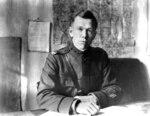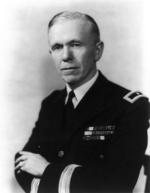George Marshall
| Surname | Marshall |
| Given Name | George |
| Born | 31 Dec 1880 |
| Died | 16 Oct 1959 |
| Country | United States |
| Category | Military-Ground |
| Gender | Male |
Contributor: C. Peter Chen
ww2dbaseAs a youth, George Marshall was considered shy and reserved. He graduated from Virginia Military Institute in Virginia, United States in 1901 and served in the United States and Philippines until World War I, where he was sent to France to fill planning and operations roles, and later became the commanding officer of the First Army during the 1918 Meuse-Argonne offensive. He worked extensively with General John Pershing in the later years of WWI.
ww2dbaseMarshall was named by President Franklin Roosevelt as Army Chief of Staff in 1939 with the rank of brigadier general. He was credited with preparing the US Army for WW2, reorganization of the Army and the Army Air Corps, and contributed in planning Allied operations in general (including planning Operation Overload/Normandy invasion). A fellow American General, Fox Connor, commented to Dwight Eisenhower his complete confidence and respect for Marshall:
ww2dbaseConnors' comment from before the United States entered WW2 was right on target. Marshall, along with Eisenhower, were credited with being two of the American leaders who almost seamlessly aligned the goals of the American and British on many occasions, which resulted in the victories North African and European campaigns.
ww2dbaseAfter the war, Marshall served as the US ambassador to China for a brief amount of time. He actively engaged the Chinese Communists in an attempt to stop the Chinese Civil War. When the Chinese Nationalists opened an initially successful offensive campaign into Communist-held northeastern China (Manchuria), Marshall threatened Nationalist leader Chiang Kaishek with the scaling back of US aid, and Chiang gave in. While Marshall did achieve temporary peace, ultimately this would become one of the many reprieves that led to the Communists' victory in the Civil War. After the Republic of China retreated to Taiwan, Chiang said that giving in that particular demand of Marshall's was Chiang's biggest mistake.
ww2dbaseIn 1947, Marshall was named the US Secretary of State. His achievements in that role, particularly in Europe, would redeem his failures in China. He was credited with the Berlin airlift; the European Recovery Program; the military assistance to Greece, Turkey, and Israel; and the precursor discussions that eventually led to the establishment of the North Atlantic Treaty Organization (NATO).
ww2dbaseMarshall resigned in 1949 due to illness, but later in 1950 was brought out of his brief furlough to become the US Secretary of Defense. He won the Nobel Peace Prize in 1953 for the Marshall Plan that brought Europe out of the ruins of WW2. Marshall died on 16 Oct 1959.
ww2dbaseSources:
Dwight Eisenhower, Crusade in Europe
Philip Jowett, China's Wars
Wikipedia
Last Major Revision: Aug 2005
George Marshall Interactive Map
Photographs
 |  |
George Marshall Timeline
| 31 Dec 1880 | George Marshall was born in Uniontown, Pennsylvania, United States. |
| 29 Apr 1939 | US Army Deputy Chief of Staff Brigadier General George Marshall boarded USS Nashville to attend the Pan American Defense Conference in Rio de Janeiro, Brazil. |
| 10 Jun 1939 | Cruiser USS Nashville departed Rio de Janeiro, Brazil bound for Annapolis, Maryland, United States. Nashville was transporting US Army staff officers from the Pan American Defense Conference including Deputy Chief of Staff, Brigadier General George C. Marshall. Also aboard was Brazilian Army Chief of Staff General Goes Monteiro who was beginning a good-will visit to the United States. |
| 1 Sep 1939 | George Marshall was appointed as the US Army's Chief of Staff. |
| 17 Jul 1941 | George Marshall approved Leopard Gerow's recommendation to re-activate Douglas MacArthur from the retired list and plans regarding the Philippine Army; Marshall forwarded Gerow's proposals to US Secretary of War Henry Stimson for further review and implementation. |
| 27 Nov 1941 | US Army Chief of Staff General George Marshall warned US Army Hawaii and Philippine Departments that attacks on Malaya, Philippine Islands, and Dutch East Indies were now a possibility. |
| 9 Feb 1942 | George Marshall, Henry Arnold, Harold Stark, and Ernest King attended the first formal meeting of the US Joint Chiefs of Staff. |
| 1 Apr 1942 | In Washington DC, United States, General George Marshall and his General Staff enthusiastically accepted a plan, submitted by Dwight Eisenhower, for an immediate assault across the English Channel into Nazi-occupied France with ten divisions of British and Canadian troops; it was understood that the British and the Canadians would likely see a very high casualty rate from such an invasion. |
| 1 Apr 1942 | General George Marshall and Major General Dwight Eisenhower presented a plan of war to President Franklin Roosevelt. This plan included "Operation Bolero" which would see the immediate preparation of 30 divisions, of which six were to be armoured, and complimentary air-power for movement across the Atlantic Ocean within the period of a year. |
| 4 Apr 1942 | President Franklin Roosevelt's special envoy Harry Hopkins and General George Marshall departed Baltimore, Maryland, United States by plane to lay the US strategic war plans, that had already been approved by the President, before the British War Cabinet and Chiefs-of Staff Committee. |
| 21 May 1942 | George Marshall and Henry Stimson met in Washington DC, United States, concluding that there was a risk that the Japanese fleet suspected of sailing for Midway Atoll could actually be planning on conducting a major air raid against cities on the west coast of the United States. |
| 16 Dec 1944 | George Marshall was promoted to the rank of general of the army. |
| 18 Nov 1945 | George Marshall stepped down as the Chief of Staff of the US Army. |
| 27 Nov 1945 | The United States dispatched George Marshall to China in an attempt to halt the civil war between Nationalist and Communist forces. |
| 21 Jan 1947 | George Marshall was named the US Secretary of State. |
| 20 Jan 1949 | George Marshall stepped down as the US Secretary of State. |
| 1 Oct 1949 | George Marshall was named the President of the American Red Cross organization. |
| 21 Sep 1950 | George Marshall was named the US Secretary of Defense. |
| 1 Dec 1950 | George Marshall stepped down as the President of the American Red Cross organization. |
| 12 Sep 1951 | George Marshall stepped down as the US Secretary of Defense. |
| 16 Oct 1959 | George Marshall passed away at the Walter Reed Army Medical Center in Washington DC, United States. |
Did you enjoy this article or find this article helpful? If so, please consider supporting us on Patreon. Even $1 per month will go a long way! Thank you. Share this article with your friends: Stay updated with WW2DB: |
Visitor Submitted Comments
All visitor submitted comments are opinions of those making the submissions and do not reflect views of WW2DB.
» Casablanca Conference
» Trident Conference
» Quadrant Conference
» Cairo Conference
» Octagon Conference
» Malta Conference
» Potsdam Conference
Document(s):
» Message from Marshall and King to Returning Personnel
Related Books:
» Pearl; December 7, 1941
» Roosevelt's Centurions
» The Generals: American Military Command from World War II to Today
- » 1,150 biographies
- » 337 events
- » 43,917 timeline entries
- » 1,241 ships
- » 350 aircraft models
- » 207 vehicle models
- » 374 weapon models
- » 123 historical documents
- » 260 facilities
- » 470 book reviews
- » 28,544 photos
- » 432 maps
Winston Churchill
6 Dec 2011 10:34:05 AM
is this true about him